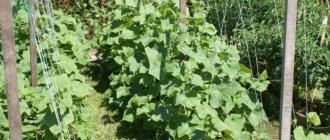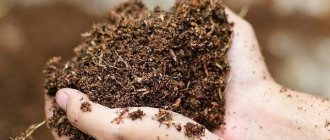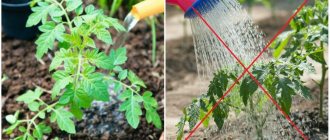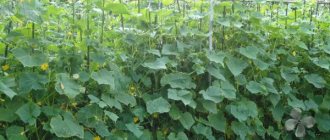Vegetable growing » Cucumbers
0
2087
Article rating
Kira Stoletova
To get a good harvest of cucumbers, you need to know some rules and characteristics of the varieties, as well as follow all the rules of cultivation. The distance between cucumbers when planting is one of the important factors.
Distance between cucumbers when planting
Where to start growing cucumbers correctly
Before planting cucumbers, choose a place where the future crop will grow - in a greenhouse or open ground. Climatic conditions and sowing time affect the method of planting the plant in the soil - seeds or seedlings. The choice of variety depends on these indicators. Planting by seedlings, all other things being equal, speeds up harvesting by 1-2 weeks.
Open ground
The following varieties and hybrids are suitable for open ground:
- Courage F1. The average length of the fruit reaches 12-13 cm. This hybrid is early and self-pollinating. On average, 1.5 months pass from planting to harvest. It is immune to diseases and is famous for its taste.
- Gerda . Gardeners harvest this variety 1.5 months after planting. The fruit grows on average up to 10 cm. The plant is resistant to diseases (fungus and rot).
- Connie F1. Early ripening hybrid. On average, fruit ripening time is 50 days. The size of the cucumbers reaches 8-9 cm. Connie is planted in a greenhouse and in open ground. Resistant to rot disease. The fruits are suitable for eating and pickling.
Growing in a greenhouse
The following varieties are suitable for growing in a polycarbonate greenhouse:
- Zozulya. On average, agronomists grow cucumbers for 1.5 months. The length of the fruit reaches 25 cm. The variety is high-yielding. With proper care, gardeners with 1 sq. m harvest 25 kg of fruit.
- Fontana. During the season, one bush produces up to 9 kg of cucumbers. The average fruit length is 25 cm.
- Emelya F1 is a parthenocarpic hybrid, pollinated without insects.
- Sarovsky is high-yielding and tolerates lack of lighting well.
- Matilda F1 is a self-pollinating early-ripening hybrid.
According to the harvest, they are distinguished:
- Early varieties . Early varieties include German, Buran, April. Gardeners harvest such cucumbers 40 days after planting. The fruits are small, reaching an average of 10 cm in length. The plant bears fruit throughout the season. It is self-pollinating.
- Late . Ripening period – 2 months. Late hybrids include Phoenix, September, Tournament. The variety tolerates temperature changes well. The weight of the fruit reaches 210-240 g, length - 15 cm. Such seeds are planted in the ground in July or August.
- Mid-season. Such cultures include Libella, Legend, Emerald. The average length of vegetables is 12-14 cm. The plant bears fruit throughout the season. Gardeners harvest up to 10 kg of cucumbers from a bush.
- Cold-resistant varieties. Such seeds are suitable for growing in northern regions. Altai ripens on average 40 days.
Growing methods
There are several methods for growing cucumber, each of which has its own advantages and characteristics. These methods include:
- in raised (horizontal);
- on a trellis (vertical);
- in barrels;
- on warm beds.
Horizontal planting scheme
When planting seedlings in spring, the plant density can vary from 2.5 to 3 pcs. per sq. m. For early disembarkation - 2.5 pcs. per sq. m, and at a later date up to 3 pcs. per sq. m. Placed in one or 2 rows. When placed on one side, the distance in the row between cucumbers is from 60cm to 100cm. Between rows 80-100 cm.
When placed on a ridge on both sides, the bushes are planted in a checkerboard pattern. The gap between rows is 60 cm, in the row between plantings it is 50-60 cm.
The use of sunlight and natural heat will be maximum. But caring for the crop is difficult. An overgrown bush covers the entire soil around it and prevents weed removal and harvesting. It is better not to disturb the plant stems. Otherwise, the orientation of the leaves will be disrupted. This will delay fruiting.
Scheme for the vertical method
There are many benefits to growing on trellises.
To get a good harvest, it is better to pay attention to another method, i.e. growing on a trellis. In this case, they are planted in two rows. The stakes are placed. Trellis wire is attached to them on top. Low and high trellises are used.
If the trellises are low, up to 0.5 m, the plants are not tied up. They just throw themselves over the wire. Using a high trellis, more than 1 m, cucumber bushes are formed into one stem and must be tied with twine. The advantages of this growing method include the following factors:
- significant space savings;
- availability of care during the growing season;
- reduced risk of disease;
- good light conditions;
- ventilation;
- long fruiting;
- clean fruits that are in plain sight.
Bushes or seedlings are planted in 2 rows in a checkerboard pattern. The distance between the rows is 80 - 100 cm. After a certain distance, holes are made for planting cucumbers. The distance between them should be 30-40 cm.
This method is usually used when growing in greenhouses or greenhouses. It is recommended to maintain a distance of at least 25 cm to the edge of the ridge. If the plants are located too close to the wall of the greenhouse, they may be poorly lit or subject to frost. These negative factors will immediately affect their growth and development.
The selected distance between the rows ensures good ventilation, uniform supply of heat and light, unhindered access to planting, watering, care and harvesting of fruits.
Scheme for growing in barrels
The method of growing in containers is quite popular. Common metal or plastic barrels and containers are often used. When grown in such containers, they are filled with grass, manure and soil. Drain well and let stand for 1 week. Then 5-8 dry seeds are sown in each and covered. After the appearance of 3 leaves, arch supports are installed and timely watering is ensured. This method has the following advantages:
- compact placement;
- minimal labor costs during care;
- clean and beautiful fruits;
- aesthetic appearance (the lashes hang to the ground, hiding the container);
- getting an earlier harvest.
In this planting method, the seeds are planted at a depth of 1-2 cm with a distance of 10 cm between them. It depends on the size of the barrel. You can plant cucumber seedlings in barrels.
Scheme for planting in warm beds
Planting in warm beds in greenhouses is possible. One of the advantages is that you don’t need to bother with seedlings, replant them and wait for them to take root. An early harvest in this option is guaranteed. This method is used by summer residents or on small farms.
For this method, you need to organize warm ridges, 30-40 cm high. Holes 20 cm deep are made in the middle. Seedlings are planted in them. The distance between plants in a row is 30-40 cm.
Preparing for landing
For better results, it is recommended to change the place for growing vegetables every five years. Different types of soil are suitable for planting cucumbers. Seeds grow best in soil containing humus.
In the southern regions, soil with a flat surface is used for planting. In regions with a cool climate, the beds are made elevated. This allows you to create a sufficient air-thermal regime.
Cucumbers grow well in soils that have adequate aeration and drainage.
Reference. It is preferable to grow cucumbers in beds where potatoes, tomatoes and corn previously grew.
Preparing the site in the fall
After harvesting in the fall, gardeners prepare the land for the new season. Choose a place for planting that is warm and well-lit. The area for vegetable crops is dug up and organic fertilizers (manure or humus) are added to the soil.
The beds are irrigated with a solution of copper sulfate. Mix 1 tbsp in 10 liters of water. l. substances. Next, according to the scheme, the weeds are removed and 2 tbsp are added to the ground. l. superphosphate and a glass of ash per 1 sq. m of land. Dig up the soil and leave it until spring.
Preparing the site for spring planting
1.5 weeks before planting, peat, a bucket of manure, sawdust and a glass of wood ash are added to the soil. Fertilizers are dug up and leveled. Irrigate the ground with hot water. To saturate the soil with nutrients, use a solution of potassium permanganate (1 g of substance per 10 liters of water).
The beds are covered with film and left until planting.
The best time to plant cucumbers
Planting dates depend on climatic conditions. The best time to sow vegetables is mid or late May. Provided that by this moment the soil temperature has established itself above +15°C, and the air temperature is not lower than +14°C. The soil temperature is checked using a thermometer. If there is a risk of night frosts, the plantings are covered with film.
In the southern regions, cucumbers are sown in open ground. In the middle zone, greenhouses are used.
Some gardeners check the lunar calendar. It changes every year. Seeds are sown for seedlings only during the waxing moon or closer to the new moon. During eclipses, it is not recommended to plant crops; this will reduce the amount of harvest.
Common landing mistakes
It is important to place plants correctly on the site and in the beds. Positioning the plants too high will cause them to suffer from the wind and overheat. Growing in lowlands is also undesirable, as it often leads to waterlogging and rotting.
Other common mistakes:
- sowing seeds too early in seedling boxes or in open ground;
- choosing the “wrong” neighbors on the site;
- lack of proper crop rotation;
- insufficiently fertile soil;
- non-compliance with the planting scheme;
- excessive plant density.
Cucumbers are harmed by too intense sunlight during the midday hours. It is advisable that the beds be partially shaded during this period of the day. Therefore, sweet corn is sown next to the cucumbers, which protects the tender shoots.
In specific conditions, it is not always possible to fully comply with all the requirements of seed producers for growing a variety or hybrid. In this regard, summer residents and farmers should remember that the qualities of a vegetable crop stated in the description are manifested only in conditions close to ideal.
Seed selection and preparation
Seed preparation takes place step by step. Before planting, seeds are selected and empty ones are removed. To do this, add 1 tbsp to a liter container of water. l. salt. Mix the solution and add the seeds. The floating seeds are thrown away, and the rest are dried on a napkin. Large seeds are selected for planting.
Advice. For planting in open ground and greenhouses, buy 2-3-year-old seeds - they will give a high-quality harvest.
Warming up the seeds
Warming up will speed up the germination process. Warm the seeds next to heating devices for a month. If there is no such amount of time, then the seeds are heated for 3 hours at a temperature of 50°C.
Disinfection of cucumber seeds
For disinfection, use a strong infusion of potassium permanganate. The seeds are immersed in water for 15-20 minutes and then washed.
Pre-planting seed feeding
To pre-feed the seeds, they are wrapped in gauze and soaked for 12 hours in a nitrophoska solution. The solution is prepared as follows: stir 1 tsp in a liter of water. substances.
After feeding, the seeds are washed and placed in a dry and warm (at least 25°C) place for swelling. Two days later, roots 2 mm in size appear.
Preliminary stratification of cucumber seeds
During stratification, the seeds are placed in the cold to awaken them before planting. To do this, they are put in the refrigerator for a day. Now the crop is ready for planting.
Variety selection
The variety must be selected depending on the location of the farm, natural and climatic conditions, and the length of daylight hours. Conventionally, varieties can be divided into three groups:
- greenhouse, with a fruit length of more than 30 cm;
- beds, planted in open ground, fruit length 10-15 cm;
- gherkins, no more than 10 cm in size.
The culture is divided into types according to the method of pollination: self-pollinating and cross-pollinating. Cross-pollinated plants have two varieties: insect pollination and wind pollination. The latter cannot attract insects with their flowers, but they release a lot of pollen, which is lifted by the wind above the plants.
This factor is important for further choosing the planting method and determining the distance between the bushes.
Planting cucumbers for seedlings
The seedling growing method allows you to get the harvest two weeks earlier.
To plant seeds, use a container 11-12 cm high. Plastic cups are suitable.
The soil is fed with 1 part sawdust, 2 parts humus and a solution (10 liters of water, 1.5 tablespoons of nitrophoska and 2 tablespoons of ash). Sprouted seeds, one at a time, are sown in each container and watered. Place it on the windowsill.
When the plant has a second true leaf, do the first feeding (3 liters of warm water and 3 teaspoons of nitrophoska). Until planting in the ground, seedlings are irrigated once a week.
Not rarely and not too often
Why is it so important not to thicken the plantings and not make them too sparse? The fact is that if one plant is too far from another, then the land will not be used rationally. In this case, the number of bushes in the borage plot (and, accordingly, the harvest) will be less.
If, on the contrary, the distance between cucumbers exceeds acceptable standards, then unwanted problems may appear.
For example, an outbreak of one or another cucumber disease. Or – “unhealthy competition” for light, water and nutrition between plants, which also leads to their weakening, sores, and loss of yield. Well, or the appearance of barren flowers instead of female flowers (which is completely undesirable).
What planting scheme for cucumbers can be considered the most optimal?.. It depends on several factors: the methods and location of planting the vegetable crop.
Methods for planting cucumbers in open ground
Vegetables are planted in open ground in two ways - seedlings and using seeds. Planting density per 1 sq. m is 1-2 bushes.
Reference. In the southern regions, cucumbers are planted in two passes. Salad varieties are sown at the beginning of spring, and pickling varieties are sown at the beginning of summer.
Using seeds
Before sowing, the bed is irrigated with warm water. Make even furrows 20-30 mm deep. The soil is crushed so that there are no lumps. The seeds are placed at the same distance so that the sprout looks straight up. Sprinkle with earth.
After sowing, mulch the soil with 1.5 cm of humus. This method prevents the appearance of a crust on the ground.
Planting seedlings in open ground
Seedlings are planted in the ground 25 days after planting the seeds. In regions with a warm climate, these actions are carried out at the end of May, in the temperate zone - in early June. Before planting, the soil is disinfected with potassium permanganate. Add 1 g of potassium permanganate to 10 liters of water.
Young plants are planted in the ground using two methods: horizontal and vertical.
Horizontal
Horizontal methods include:
- Wide row method. Seedlings are planted in rows at a distance of 30 cm from each other. Leave 100 cm between rows.
- The usual method. Plants are planted in the ground, leaving 60 cm between rows.
Vertical
The vertical method includes the belt method. This planting method is suitable for long areas. The distance between plants is left 70-90 cm.
The photo below shows all planting methods.
What should be the distance between the beds
Maintaining certain distances when planting cucumbers is a necessary condition for the normal development of plants and disease prevention. It is necessary to take care of a sufficient feeding area for adult specimens during site planning, arranging beds, and planting seedlings.
Seeds
The holes are arranged in 1 or 2 rows. On horizontal beds, place 3 seeds in one hole (for direct sowing). There will be enough feeding area for the seedlings, but in the future adult cucumbers will not be comfortable. Therefore, you should thin out the seedlings when real leaves appear on them. Leave 1 or 2 of the largest seedlings out of three.
See also How to get rid of aphids on cucumbers: effective folk remedies and preparations
When sowing seeds of bee-pollinated cucumbers, make holes at a distance of 30–35 cm. The interval between the beds is 50 cm. Self-pollinating and parthernocarpic varieties are planted at the rate of 3 seeds per 1 m2. The gaps between mature plants should ultimately be 40–60 cm (in a row).
Seedling
Cucumbers are sown in special seedling cassettes and peat pots. Placed on window sills or placed in greenhouses. If the diameter of the pot is at least 8 cm, then fill it 2/3 with fertile substrate, lay out 2-3 pre-soaked seeds on the surface. A thin layer of humus is poured on top and watered.
Expert opinion
Stanislav Pavlovich
Gardener with 17 years of experience and our expert
Ask a Question
Ready seedlings are planted so that there are 2–3 plants per 1 m2. When placing cucumbers in two rows, the distance between the rows should be from 80 to 140 cm. When planting in a checkerboard pattern, intervals of 50–60 cm are made in the row, and 60 cm between the rows.
How can the characteristics of the variety affect
The planting method depends on such characteristics of cucumbers as the length of the side shoots and the size of the fruit. It is recommended to study the features in advance, before sowing in the ground or planting seedlings. The optimal location for large-fruited cucumbers is one or two plants per 1 m2. Small-fruited varieties can be placed 3-4 bushes per 1 m2. In each case, it is recommended to leave at least 80 cm between rows.
Soil fertilization
The soil is fertilized not only in autumn and spring, but also after planting cucumbers in the ground. For this purpose, mineral and organic fertilizers are used. 14 days after planting the seedlings in the beds, the cucumbers are fed with a solution of manure. With the seed planting method, this activity is carried out when the plant has two true leaves.
When fruits form on the plant, gardeners feed it with nitrogen, magnesium and potassium. Fertilize the vegetable crop with a solution of ammonium nitrate or potassium salt. During flowering, plants are fed with a solution of manure. It is diluted with water 1:5. They insist for 14 days. Dilute in water in a ratio of 1:2 and water the roots generously.
Reference. Chicken manure is rich in nitrogen, potassium, magnesium and phosphorus. These substances have a positive effect on plant immunity.
What can result from an illiterate planting arrangement?
In order for cucumbers to fully develop, it is necessary to leave the same intervals as for adult plants when sowing seeds and planting seedlings in a permanent place.
Tight
If plants are crowded together, they receive little light. Ventilation, necessary for normal gas exchange and evaporation of water by leaves, deteriorates. Other negative consequences of close placement of cucumbers are poor pollination and susceptibility to fungal infection. The buds rot, and empty flowers form even in self-pollinating varieties. The intervals between adult cucumbers should not be less than 20 cm.
Sparse
When planted sparsely, it is easier to care for the plants and there are better conditions for ventilation. However, in this case, the site, the area of the greenhouse, is used ineffectively. The owner collects less fruit from the few bushes. A sparse planting is considered to be such a planting in which the distance between cucumbers in one row is more than 60 cm. Sometimes larger intervals are required for varieties with powerful shoots and large fruits.
Care instructions
After planting a vegetable crop in the ground, gardeners follow a number of rules that increase yields:
- Cucumbers are fed once every 10 days. Fertilize the plants with manure, urea, superphosphate and potassium salt. Feed the crop in the evening along with watering.
- During the period of leaf development, the soil is fertilized with nitrogen. When flowering - phosphorus. Potassium is added when the plant bears fruit.
- Adult plants are watered every day or every other day with warm water. The liquid is settled and heated in barrels in the sun. Water temperature – at least 20°C.
- Cucumbers are not watered at the root. This erodes the soil. Moisture stagnates at the roots and mold occurs. Use a watering can with a nozzle or the drip method. For this, a plastic bottle without a bottom is suitable, which is placed near the bush with the neck down; through the holes in the lid, water gradually flows to the roots of the plant.
- For proper growth, cucumbers are tied in the greenhouse with synthetic twine or hemp. The twine is wrapped around the plant.
- Cucumbers are not planted next to tomatoes, since these crops require different growing conditions and watering.
Distance between seedlings
To get a bountiful harvest in a greenhouse, it is recommended to adhere to the deadlines for planting cucumber seedlings or seeds. Cucumbers are planted taking into account the optimal distance of seedlings from each other. In this case, they are able to obtain comfortable conditions, and the plants develop quickly and fully.
Cucumber bushes are planted in the greenhouse at a distance of 20 to 40 centimeters. Let us present in the table what you may encounter in cases of thickened and sparse planting of cucumbers.
| Planting too thick | Sparse landing |
In this case, you may encounter a large number of negative phenomena:
| In this case, the useful area of the greenhouse structure is used irrationally. As a result, the harvest is small, which is economically unprofitable. |
The solution to the problem depends on the distance at which one plant is planted from another, and on what varieties the gardener plans to grow. Professional gardeners recommend planting 3 to 4 specimens per square meter. 40-60 centimeters are left between the holes, and cucumbers are planted from row to row at a distance of 90 centimeters.
Caring for a cucumber patch
After the plants have begun to grow, it is important to create good conditions for their further growth and development. And you need to start with regular watering. During the period of seedling growth under the covering material, you do not need to water them often, since the film does not allow moisture to evaporate too quickly.
Favorable growth
Planting cucumber seedlings in open ground
After the shelter is removed, the cucumbers need to be watered once every 3-4 days, and in hot weather and during the flowering and fruiting period - once every two days or every day. Watering time - morning or evening hours.
Water for irrigation should be constant and warm, and cold moisture can cause rotting of the roots.
It is important to know! The correct watering regime and maintaining air humidity are the main conditions for the good development of cucumbers!
After the bushes have 5-6 permanent leaves, they will need to be tied up. To do this, a net is stretched in each row (if the cucumbers grow in open ground). In greenhouse conditions, it is better to install trellises for tying.
Do not forget about loosening the soil and timely removal of weeds. After watering, you can mulch the tree trunk circles of cucumber vines, then the moisture will not evaporate intensively in hot weather, and a layer of mulch also prevents the active growth of weeds.
An important stage in caring for cucumbers is fertilizing. It is necessary to fertilize cucumbers at all stages of their development, starting from the period of increasing vegetative mass and ending with the ripening of the greens.
How to plant cucumbers in the garden
Knowing how to plant cucumbers in open ground and at home as seedlings, you can get healthy, strong seedlings.
Seedlings
Seedling
Transplanting cucumbers into open ground
Proper planting of seed material for seedlings implies, first of all, the correct choice of cucumber varieties that will be grown in the garden. Purchased seeds usually do not require additional disinfection; they should only be soaked for 24 hours for germination in a damp cloth.
It is better to prepare the soil for planting yourself; you should not add peat fertilizer to it, which promotes the rapid removal of moisture. It is better to make a mixture of the following components: turf (or leaf soil, compost (or humus) and coarse river sand. What composition of the mixture to choose is decided by the summer resident himself, but it is better if it is as close as possible to the soil that will be in the area with the beds. Such a nutrient mixture will be loose, it retains moisture well, and oxygen reaches the roots.
You should also provide cucumber seedlings with proper lighting during the growth period - daylight hours should be at least 10-11 hours. If necessary, plants require additional lighting with any lighting fixtures. At night, these vegetables are not illuminated.
Advice! It is better to plant plants in separate cups so that the thickened crops do not have to be planted later.
Before sprouting, it is better to cover the containers with film to create a greenhouse effect.
Proper further care of the sprouts consists of timely watering, maintaining the required temperature and humidity level in the room for good development of cucumber plants, as well as applying at least two fertilizing treatments before transplanting the seedlings outside.
Cucumber seedlings are transplanted to a permanent location in the phase of 2-3 true leaves. If the night air temperature is much lower than the daytime temperature, you need to make a shelter for the seedlings - a low greenhouse that will protect the seedlings from the night cold.
Planting cucumbers under covering material
Seeds
Before planting cucumber seeds directly in a permanent place, you must first select a well-lit area that is protected from strong winds and prepare the beds. The soil on it should be fertilized in the fall: organic fertilizers (cow manure, compost or humus) are added during digging, and beds are formed on loose soil in the spring. It is better to direct them from north to south, so that the cucumber vines are illuminated from different sides during the day as they grow.
When to plant cucumbers in the ground depends on weather conditions, this vegetable crop is usually planted with seeds from mid to late May, but planting is possible in early June (but no later). The seeds are buried 1-1.5 cm into the soil; it is better to sow already germinated seed, then seedlings appear several days earlier.
The soil is well watered, the crops are covered with film so that sprouts appear faster.
Watering cucumbers in a greenhouse
Planting schemes
In order to plant seeds in open ground, first smooth furrows are made in the beds, into which the germinated seed material must be planted. The distance between plants should be at least 0.4 m, and between rows - at least 0.6 m. This scheme for planting cucumbers is optimal - the bushes do not interfere with each other, they grow freely, without casting a shadow on neighboring vines.
When planting seedlings, you need to remember the number of bushes per 1 m2 should not exceed 3-4 pieces, otherwise the plants will interfere with each other’s normal development.
Common problems associated with growing
Despite the ease of caring for cucumbers, various unpleasant moments may arise:
- If a plant produces a peduncle, but the fruits do not set, the reason may be not only poor-quality seeds, but also: lack of light, drying out of the soil, improper watering of the plant (with cold, not warm water), an excess of nitrogen fertilizers, etc.
- If cucumbers grow crooked, this indicates a lack of nutrients - nitrogen. potassium, phosphorus.
- The fruits are bitter. If not only the peel, but also the cucumber itself turns out to be bitter, this is the result of the accumulation of a special substance, cucurbitacin, inside them. The plant can react to any stress in a similar way. Any unfavorable conditions that were created during the growth and development of culture can become an impetus for this.
- Cucumbers grow, but wither - look for a problem in the root system of the plant. It may experience excess moisture or even be damaged by rodents and other garden pests.
- Leaves that turn yellow ahead of schedule most often indicate a lack of potassium, magnesium, phosphorus and iron.
- The marbled yellowness of the leaves indicates that the plant is infected with spider mites. In addition, there are other crop pests - ants, whiteflies, aphids. When growing cucumbers in a greenhouse, the risk of plant damage is reduced.
- Common diseases of cucumbers are olive spot (cladosporiosis), powdery mildew (downy mildew), gray and root rot. To prevent these diseases, disinfectant solutions, for example, Fitosporin, should be used before sowing.
Growing cucumbers does not require any special agrotechnical knowledge; if you follow all the recommendations of experienced vegetable growers, you can get a good harvest of cucumbers year after year.
Vertical
This method is used both in greenhouses and in the open space of the site. The cucumbers stretch upward and rest on the trellis.
Such conditions are the most favorable for green pets. Caring for them and harvesting also distinguishes vertical plantings from horizontal ones (without garter). And the compactness of the location is also important.
Technologies for increasing productivity
To increase the yield of cucumber vines, you need to remember to comply with the following conditions:
- the soil in the beds should be moist all the time;
- air humidity cannot be less than 55-60%;
- regular fertilizing.
Properly applied fertilizers can significantly increase the yield of planted cucumber varieties. Before flowering begins, fertilizers containing a large amount of nitrogen are applied to the soil. When the ovaries appear, mineral supplements containing phosphorus and potassium are applied under the vines of this vegetable crop.
You can alternate organic and mineral fertilizers.
0 0 votes
Article rating











